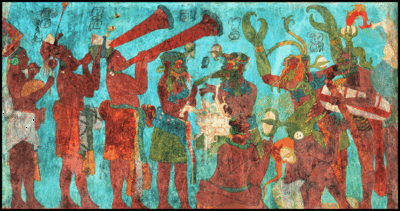- Maya music
-
The Music that was central to pre-Columbian Maya culture still remains a bit of a mystery today. On the other hand, many aspects of Maya music have come to light from archaeological discoveries, ancient Maya murals, and ancient Maya texts. It is evident from these sources that music played a key role in the expressive arts of Maya culture. Music served many functions in Maya society, not to mention the role society played on music itself.
Contents
Functions of Maya music
It is believed that musicians served many ceremonial functions in ancient Maya culture. In various funeral ceremonies, it is believed that a procession of drum and flute players would follow the casket of important women, filling the air with a gloomy and natural tune. After the casket is laid, the musicians would then cast their instruments, breaking them in the tomb just before it is sealed.
Music also filled the halls of Bonampak after victories of war. In the ancient murals of the Maya city, conch trumpet players are depicted playing for the leaders of their city after a successful campaign. In a display of skill and artisanship, the murals of Bonampak clearly illustrate that musicians, while servants of the city lords, were held in much higher regard than common townsfolk.
Common people in Maya culture did, as well, share interests in music. Archaeological finds have unearthed many unadorned drums and whistles in lower class housing. While it is unclear whether such instruments were reserved for ceremonial traditions, it is certain that simple drums and whistles filled many houses in ancient Maya territories.
The instruments
There were several classes of instruments in Maya culture: Percussion instruments of the Pre-Columbian era included mainly drums and maracas, mostly wood and occasionally tortoise shell. Archaeological evidence from the Pacbitun site also shows that sophisticated forms of maracas along with the small balls inside the hollow maracas were actually crafted in fired ceramic materials.
In the same find, archaeologists discovered additional ceremonial flutes and ocarinas. Similarly crafted out of fired ceramic, the flutes and ocarinas of Pacbitun represent the most extravagant and unique collection of Maya instruments. While most flutes and ocarinas of their time consisted of bone, wood, or reed material, this unique collection sheds light on the important aspect of music in Maya culture. No remnants of pre-Columbian stringed instruments were found until archaeologists discovered a jar in Guatemala, attributed to the Maya of the Late Classic Era (600–900 CE), depicting a stringed musical instrument which has since been reproduced. This instrument is astonishing in at least two respects. First, it is the very few string instruments known in the Americas prior to the introduction of European musical instruments. Second, when played, it produces a sound virtually identical to a jaguar's growl.[1]
References
- Bourg, Cameron Hideo.(2005) Ancient Maya Music Now With Sound: A Thesis
Submitted to the Graduate Faculty of Louisiana State University and Agricultural and Mechanical College in partial fulfillment of the requirements for the degree of Master of Arts in the Department of Foreign Languages and Literatures By B.A., L.S.U., 2003 December
- Editors of "Archaeology Magazine" (2002) Secrets of the Maya. Hatherleigh Press, Long Island City, NY, ISBN 1-57826-123-6.
- Houston, Stephen et al. (2006) The Memory of Bones: Body, Being and Experience Among the Classic Maya. University of Texas Press, Houston, ISBN 978-0-292-71294-2.
- Orellana, Sandra L (1984) The Tzutujil Mayas: Continuity and Change 1250-1650. University of Oklahoma Press, Norman.
- Sadie, Stanley. (2001) The New Grove: Dictionary of Music and Musicians. Second Edition Vol. 16, MacMillan Publishers Limited
- Sheeny, Daniel E., Bruno Nettl, Ruth M. Stone James Porter and Timothy Rice. (1998–2002) The Garland Encyclopedia of World Music. The Music and Mexico’s Native People by: Nations and Musical Traditions Native Musical Traditions: Native Musical Instruments, Garland Publishers. Vol 2. New York,
- Stevenson, Robert. (1971) Music in Mexico: A Historical Survey. Apollo Edition
- Tedlock, Dennis (tr.) (1985) Popul Vuh: The Mayan Book of the Dawn of Life. Simon & Schuster; New York, NY.
Discography
- Ah-Kin. 1996. Children of the Moon. Ah-Kin Bonampak. Earthtone Records
- Berenholtz, Jim and Mazatl Galindo. 2004. The Land of the Feathered Serpent. Hu Ra.
External links
Ancient music Music of ancient Iraq · Music of ancient Egypt · Music of ancient China · Music of ancient India · Music of Persia · Music of ancient Greece · Music of ancient Rome · Pre-Columbian Maya music · Ancient Celtic musicPreceded by Prehistoric music - Succeeded by Early music Categories:- Mesoamerican music
- Maya society
- Maya art
- Ancient music
Wikimedia Foundation. 2010.


